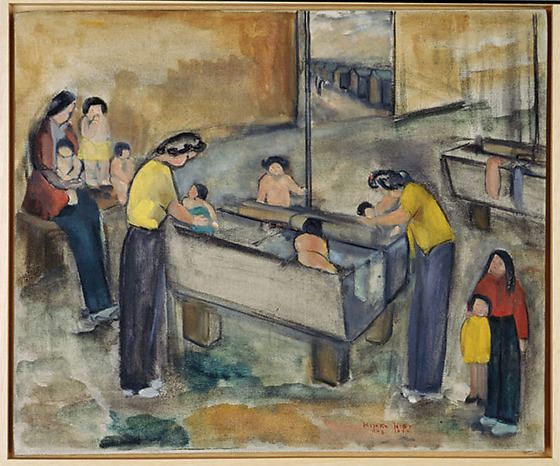Full Name Hisako Shimizu Died October 25, 1991 Name Hisako Hibi | Years active 1927–1991 Nationality American Books Peaceful painter | |
 | ||
Occupation Painter, teacher and printmaker Spouse(s) Matsusaburo 'George' Hibi(1886–1947) Children Satoshi (son, b.1931);Ibuki (daughter, b.1937) | ||
Hisako Shimizu Hibi (1907–1991) was an Issei painter and printmaker who exhibited throughout her career, and by the end of her life she was well entrenched in the San Francisco Bay Area arts community.
Contents
Early years
She was born on May 14, 1907, in Torihama, a farming village near Kyoto, Japan, the eldest of six children and stayed with her grandmother after her parents moved to the United States. She reluctantly moved to San Francisco, California in 1920. After her father's business prospered, her parents returned to Japan, but Hibi stayed in the United States, graduating from Lowell High School in 1929. Hibi studied western-style oil painting at the California School of Fine Arts and participated in annual exhibitions at the San Francisco Art Association.
While at the school, she met fellow student and painter George Matsusaburo Hibi, who was more than twenty years her senior, and the two were married in 1930. In 1933, the couple moved first to Mount Eden, and then to Hayward, California, where they raised their two children.
Internment
In 1942, with forced removal imminent, Hibi and her husband donated their paintings to different venues in the Hayward community, to express their thanks for their support with the knowledge that they couldn't bring the work with them into the American concentration camps for the duration of World War II. The Hibi family was first moved to the Tanforan Assembly Center in May and then to the more permanent camp at Topaz, Utah in September. At Tanforan, the Hibis and several other interned professional artists, including Byron Takashi Tsuzuki and Miné Okubo organized the Tanforan Art School under the leadership of Chiura Obata within the first month of internment.
The family's eviction was documented by photographer friend Dorothea Lange, who captured Hibi with her daughter Ibuki standing aside mountains of luggage on 8 May 1942 as they waited for the buses that would take them to the assembly center.
While interned in Tanforan and Topaz, Hibi created seventy-two paintings and taught classes in drawing, painting (oil and watercolor) and sculpture to students at the Topaz Art School, which was the resumption of the Tanforan Art School. While both Hibi and her husband George were influenced by late nineteenth-century European and American painters, Hibi was particularly influenced by the work of Mary Cassat. Many of her oil paintings from the camp years depict the intimate daily life of mothers at work, the cold sterility of the barracks, and images such as persimmons and New Year's rice cakes, that symbolized a nostalgia for a previous life. In 1943, she received a prize for a still life of flowers that was exhibited in a show of work by incarcerated artists that was held at the Friends Center in Cambridge, Massachusetts.
Of the seventy-two paintings, one is in the collection of the Oakland Museum of California, one was given to the San Francisco Buddhist Church, seven are in a private collection, and sixty-three were donated to the Japanese American National Museum between 1996 and 1998. Some of the works that George Hibi created while interned are stored at UCLA.
Post-war years
After the war the Hibis relocated to New York City. Tragically, George Hibi died shortly afterwards in 1947, and to support herself and her children, Hibi took up work as a seamstress in an garment factory. She later returned to school, studying under Victor D'Amico at the Museum of Modern Art which influenced her painting style, becoming increasingly abstract. In 1953, Hibi became a U.S. citizen, taking advantage of the Immigration and Nationality Act of 1952. A year later, she moved back to San Francisco where she remained until her death in 1991. A neighbor from Hayward, who had stored several of the family's paintings, had died by 1954, and many of the early works were lost. Hibi exhibited widely in the Bay Area in the postwar years, where her first solo exhibit was held at the Lucien Labaudt gallery in 1970. In 1985, the San Francisco Arts Commission presented Hibi with an Award of Honor, and mounted a major solo exhibition Hisako Hibi, Her Path at the Somar Gallery. She was an early member of the Asian American Women Artists Association.
Hibi died on October 25, 1991, in San Francisco, at the age of 84. Her memoir, Peaceful Painter: Memoirs of an Issei Woman Artist was edited by her daughter Ibuki and published posthumously in 2004 by Heyday Books, along with an accompanying exhibition at the Japanese American National Museum. Hibi's granddaughter, Amy Lee-Tai, wrote a children's book based on the experiences of the Hibi family in Topaz.
